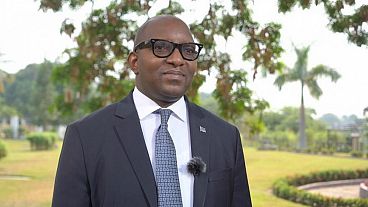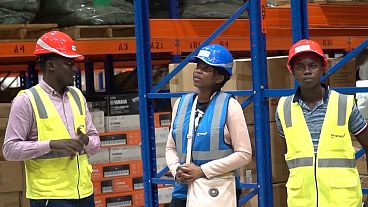By Sabina Zawadzki
LONDON (Reuters) - Mozambique, one of the world's poorest nations, is set to become a top global gas exporter thanks to two huge terminals about to be built in a northern province.
The two liquefied natural gas (LNG) projects, by Anadarko and Exxon Mobil, will extract, liquefy and ship gas, found in such quantities offshore Mozambique that it amounts to a decade's worth of European consumption.
But the plans by the U.S. companies diverge in their financing, marketing and shipping strategies, reflecting uncertainties in a growth industry that has yet to achieve the flexibility and liquidity of its sister crude oil market.
Exxon will use its might as a decades-old LNG producer with a 20-million-tonne portfolio to partially pay for the project and absorb the LNG - together with its equally hefty partners.
LNG novice Anadarko, meanwhile, has had to go through the time-consuming process of locking in long-term buyers for its gas and multi-billion-dollar financing from banks mindful of Mozambique's 2016 credit default and geopolitical hazards.
For this reason, Anadarko's project has been fully exposed to risk assessments made by buyers and financial institutions.
"I think what they've done is built the first project that across the board responds to the shifts to contract structures and pricing and how you finance an LNG project," said Jason Feer of Poten & Partners, an industry consultancy.
Although the gas projects are 1,000 km (600 miles) north of Beira, the town at the heart of the devastation caused by a cyclone and floods last week, the country's poor infrastructure and flare-ups of violence are also large risks.
Industry insiders say Anadarko will avoid the fate of London-listed Ophir Energy, which ended up losing its Equatorial Guinea licence, its chief executive and over $300 million after it failed to get financing for its LNG project.
But concessions have been made by Anadarko and its partners Mitsui, Mozambique state energy company ENH, Thailand's PTT and Indian energy firms ONGC, Bharat Petroleum Resources and Oil India.
ANADARKO'S CONCESSIONS
Anadarko had to seal binding contracts with long-term buyers of the LNG it plans to produce to present to banks as proof of the venture's viability before receiving financing for what it hopes is two-thirds of the cost of the $20 billion project.
But in a fast-expanding, volatile market, such multi-year, multi-billion-dollar commitments are difficult to clinch.
"There are multiple price indexations, some flexibility in terms of volumes and there are a variety of contract durations," said Gary Regan of industry consultancy Gas Strategies.
"Those are some of the ways in which they had to provide concessions to buyers during negotiations."
Over 9.5 million tonnes a year (mtpa) of the project's 12.88 mtpa capacity is committed to eight buyers from seven developed and developing countries with various credit ratings, including utilities, major LNG portfolio holders and two state companies.
The contract duration varies from 13 to 20 years and volumes range from 0.28 mtpa to 2.6 mtpa.
(GRAPHIC: Anadarko's long-term buyers of LNG from Mozambique project - https://tmsnrt.rs/2Hx1sIC)
All of the contracts are on a delivered ex-ship (DES) basis, Anadarko told Reuters, which means the company needs to organise LNG shipment. This is risky as the LNG tanker market, tiny and undeveloped by global shipping standards, is volatile, experiencing record-high charter rates last year.
Finally, Anadarko had to lock in lower LNG prices than in the last wave of projects. One source familiar with the matter pegged Anadarko's prices above 11 but below 12 percent of Brent crude oil, compared to 14 percent five to seven years ago.
Anadarko said its contracts had exposure to crude oil and gas index-linked prices but declined to comment further.
There is every chance Exxon too will face low prices for its LNG but as it need not lock them in now, it can market the gas when it chooses to do so and for the best price.
"Balance sheet financing by majors such as Exxon enables projects to proceed at optimal timing regarding contract strategy and market openings," Credit Suisse analyst Saul Kavonic said.
Exxon did not immediately respond to a request for comment.
(GRAPHIC: Spot Asian LNG, Brent crude and LNG shipping rates - https://tmsnrt.rs/2Cw3uUY)
RISK IT LATER
Anadarko said it would take a final investment decision (FID) by June thanks to the offtake agreements it now has providing the financing is agreed - still a significant hurdle. But once it does, it has a smoother path to production, due in 2024.
"We are well placed to meet the objective of taking FID in the first half of this year," an Anadarko spokeswoman said.
Exxon, meanwhile, has effectively pushed back the risk Anadarko has had to face today closer to the start date of its own project, also 2024.
Together with partners Eni, the Italian major from which it took over the project in December 2017, LNG buyer Korea Gas Corp and state-owned China National Petroleum Corp, Exxon will take on the LNG volumes itself in a bet that there will be sufficient demand in 2024.
Exxon is also seeking project financing but its experience, robust balance sheet and eager LNG consumers as partners, mean finding money will be easier, industry sources say.
Here, Exxon is like Royal Dutch Shell, which has the world's largest LNG portfolio and which took FID on the $30 billion LNG Canada project in October with few buyers signed.
"The majors have kind of had to make a judgment call," said Freer of Poten & Partners.
"They've had to decide they're not going to be in the LNG business because they don't have the pre-sales, or they've had to take more risk on the balance sheet. And the decision is they believe the demand for LNG is there."
(Reporting by Sabina Zawadzki; Additional reporting by Jessica Jaganathan in Singapore; Editing by Dale Hudson)



